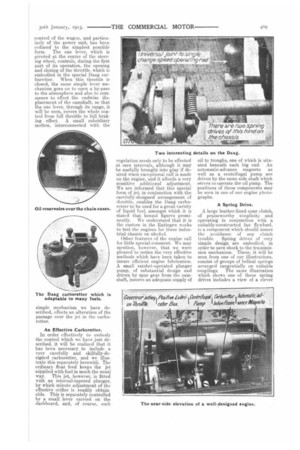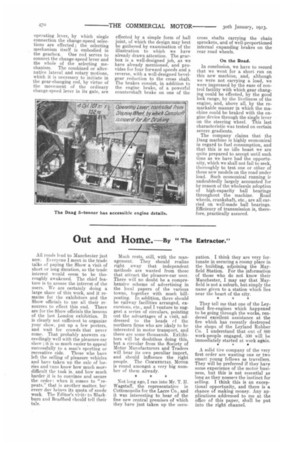The New Daag,
Page 6

Page 7

Page 8

If you've noticed an error in this article please click here to report it so we can fix it.
First Published Particulars of an Interesting New German Five-tonner, the Forerunner of a New Range of Models to be Introduced to Great Britain.
New models of industrial-motor vehicles are being offered to the buying public with remarkable frequency at the present time, a sure indication of the fact that many alert minds are awake to the still greater developments which are imminent in respect of the employ ment of such machines. In this
present issue we are able to find room for descriptions of several interesting new machines, and not the least noteworthy of these is a fine new five-tonner, which is the first of a range which is to be introduced to this country by the 11.A.L.D.A. Motor Association of Herman Hill, South Woodford, Essex.
Subsidy Models.
These machines, which are new to this country, although very familiar
in many parts of Europe, are manufactured by the Deutsche Last Automobil Fabrik Aktien-Gesellschaft. They are models which have not failed to secure the German Government subsidy. They are also of types which are approved by other Continental Governments. The load-carrying range of the models which this German house, whose works, by the way, are at Ratingen, Dusseldorf, markets is as follows : two-and-a-half tons ; three tons ; three-and-a-half tons ; four tons ; and five to six tons. The first example to be shipped is of the 4000-5000 kilo. load-carrying class, but its English sponsors have decided to market it definitely as a five-twiner.
Its general arrangement may readily be gathered from the sectional elevation and plan drawings which we are, by the courtesy of the M.A.L.D.A. people, in a position to reproduce. In addition, we have been afforded the opportunity to secure a number of interesting detail photographs, and reprod,uctions of some of these appear on the present pages.
A Chassis of European Reputation.
After a careful examination of the constructional details of this new model, we have formed the general impression that it is a welldesigned machine, carefully pmportioned, of convincing outline, and of high ton-mileage capacity. One of the conventional arrangements of the principal component parts has been a,dopted, that is to say, that a four-cylinder vertical engine. driving through a cone clutch, and
a long propeller shaft, transmits its power to a four-speed gearbox, the casing of which also houses the differential gear and differential sprocket shafts, the final drive being by substantial roller chains to the rear road wheels. The Daag five-tonner has, however, quite a number of outstanding de tail features of specific interest. We are not surprised to hear that one of the master hands which designed the world-famed Saurer model has had much to do with the production of the llaag, many hundreds of which are running successfully on the Continent.
The Engine Air Brake.
The engine is a four-cylinder one on the ordinary four-stroke cycle, and there is little of novelty in regard to its general arrangement, with the one noticeable exception in respect of the. provision of its air-braking device, a characteristic which, it will be remembered, is distinctive of the Saurer design. The method adopted to secure engine braking on this five-tonnerand we presume similar provision is made on the smaller models—is to arrange for the temporary endwise displacement of the camshaft in such a way that air is drawn into the cylinders and compressed on each stroke. In other words, the engine is thus readily converted into an air compressor. In this connection, it should be noted that the
control of the wagon, and particularly of the power unit, has been reduced to the simplest possible form. The one lever, which is pivoted at the centre of the steering wheel, controls, during the first part of its operation, the opening and closing of the throttle, which is embodied in the special Daag carburetter. When this throttle is closed, the same simple lever mechanism goes on to open a by-pass to the atmosphere and also to commence to effect the endwise displacement of the camshaft, so that the one lever, through its range, it will be seen, covers the whole control from full throttle to full braking effect. A small subsidiary motion, interconnected with the simple mechanism we have described, effects an alteration of the passage over the jet in the carburetter.
An Effective Carburetter.
In order effectively to embody the control which we have just described, it will be realized that it has been necessary to include a very carefully and skilfully-designed carburetter, and we illustrate this separately herewith. The ordinary float feed keeps the jet applied with fuel in much the usual way. This jet, however, is fitted with an internal-tapered plunger, by which minute adjustment of the effective orifice is readily obtainable. This is separately controlled by a small lever carried on the dashboard, and, of. course, such
regulation needs only to be effected at rare intervals, although it may be usefully brought into play if desired when exceptional call is made on the engine, and it affords a very sensitive additional adjustment. We are informed that this special form of jet, in conjunction with the carefully-designed arrangement of throttle, enables the Daag carburetter to be used for a great variety of liquid fuel, amongst which it is stated that benzol figures prominently. We understand that it is the custom in the Ratingen works to test the engines ror these industrial chassis on alcohol.
Other features of the engine call for little special comment. We may mention, however, that we were pleased to notice the very effective methods which have been taken to insure efficient engine lubrication. A small ratchet-operated plunger pump, of substantial design and driven by spur gear from the camshaft, insures an adequate supply of oil to troughs, one of which is situated beneath each big end. An automatic-advance magneto as well as a, centrifugal pump are driven by the same side shaft which serves to operate the oil pump. The positions of these components may be seen in one of our engine photographs.
A Spring Drive.
A large leather-lined cone clutch, of praiseworthy simplicity and operating in conjunction with a suitably-constructed fan flywheel, is a component which should insure the avoidance of any clutch trouble. Spring drives of very simple design are embodied, in order to save shock to the transmission mechanism. These, it will be seen from one of our illustrations, consist of groups of helical springs arranged tangentially on suitable
couplings. The same illustration which shows one of these spring drives includes a view of a clever
operating lever, by which single connection the change-speed selections are effected ; the selecting mechanism itself is embodied in the gearbox. One rod serves to connect the change-speed lever and the whole of the selecting mechanism. The combined or alternative lateral and rotary motions, which it is necessary to initiate in the gear-changing rod, by virtue of the movement of the ordinary change-speed lever in its gate, are effected by a simple form of ball joint, of which the design may best be gathered by examination of the illustration to which we have already drawn attention. The gearbox is a well-designed job, as we have already mentioned, and provides for four forward speeds and a reverse, with a well-designed bevelgear reduction to the cixiss shaft. The brakes consist, in addition to the engine brake, of a powerful countershaft brake on one of the cross shafts carrying the chain sprockets, and of well-proportioned internal expanding brakes on the rear road wheels.
On the Road.
In conclusion, we have to record that we went for a short run on this new machine, and, although we were not carrying a load, we were impressed by the ease of control facility with which gear changing could be effected, by the good lock range, by the liveliness of the engine, and, above all by the remarkable manner in which the ma.chine could be braked with the engine device through the single lever on the steering wheel. This last characteristic was tested on certain severe gradients.
The company claims that the Daag machine is highly economical in regard to fuel consumption, and that this is no idle boast we are quite prepared to accept until such time as we have had the opportunity, which we shall not fail to seek, thoroughly to test one or other of these new models on the road under load. Such economical running is undoubtedly largely accounted for by reason of the wholesale adoption of high-capacity ball bearings throughout the machine. Road wheels, crankshaft, etc.. are all carried on well-made ball bearings. Efficiency of transmission is, therefore, practically assured.




























